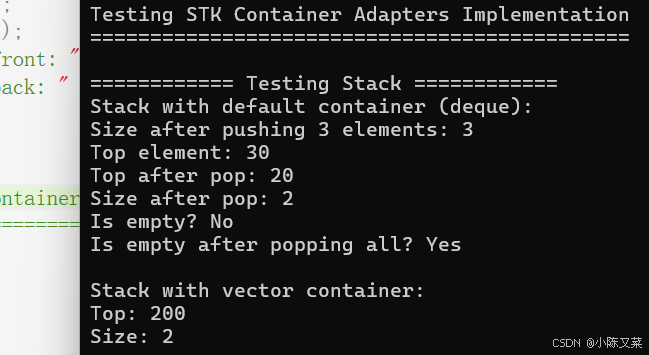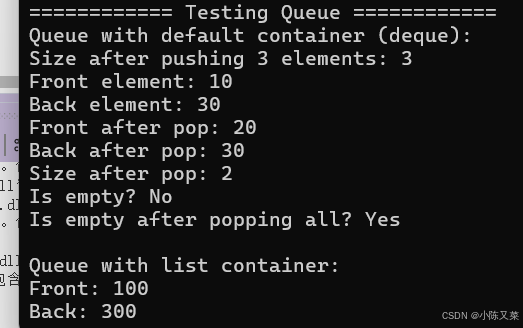个人主页:小陈又菜的主页
个人追求:做一个有梦想的程序员!
个人准则:想多了都是问题,做多了都是答案!
目录
1. Stack
1.1. stack的介绍
- stack是一个容器适配器,在专门具有后进先出的上下文环境中,只能从容器的一端进行操作
- stack作为一个容器适配器,它封装了一个STL标准容器(又叫做底层容器),但是针对后进先出的,stack只暴露特定的操作,隐藏了容器的其他非必要功能
- stack封装的底层容器可以是任何标准容器(list、vector、deque)。要求容器必须具有一下操作:
- empty() 判空操作
- back() 获取末尾元素
- push_back() 尾插
- pop_back() 尾删
- 如果并没有指定底层容器,就默认是deque
1.2. stack的使用及其模拟实现
函数说明
接口说明
stack() 构造空的栈
检测 stack 是否为空
size() 返回 stack 中元素的个数
push() 将元素 val 压入 stack 中
pop() 将 stack 中尾部的元素弹出
1.2.1. stack()
因为我们是将stack写成一个自定义类型,所以构造函数、析构函数都不需要我们自己写,编译器会自动调用。
1.2.2. 其他接口
stack是以deque为底层容器的容器适配器的一个对象,所以stack的相关接口都可以使用底层容器的,换句话说stack封装了deque。
所以服用deque来实现stack的接口的话就比较简单了:
#include <iostream> #include <deque> using namespace std; namespace stk { //stack template<class T, class Container = deque<T>> class stack { public: void push(const T& x) { _con.push_back(x); } void pop() { _con.pop_back(); } const T& top() { return _con.back(); } size_t size() { return _con.size(); } bool empty() { return _con.empty(); } private: Container _con; };
2. queue
2.1. queue的介绍
- 队列是一种容器适配器,专门用于先进先出的上下问环境中,其中从元素一端插入插入元素,另一端提取元素
- 与stack一样,queue也是一个封装了底层容器的容器适配器的一个对象
- 底层容器可以是标准类容器模版之一,该底层容器应该包含下面操作:
- empty:检测队列是否为空
- size:返回队列中有效元素的个数
- front:返回队头元素的引用
- back:返回队尾元素的引用
- push_back:在队列尾部入队列
- pop_front:在队列头部出队列
- 默认情况下,如果没有指定底层容器,则会使用标准容器deque
2.2. queue使用及其模拟实现
函数声明
接口说明
queue() 构造空的队列
empty() 检测队列是否为空,是返回 true ,否则返回 false
size() 返回队列中有效元素的个数
front() 返回队头元素的引用
back() 返回队尾元素的引用
push() 在队尾将元素 val 入队列
pop() 将队头元素出队列
2.2.1. queue()
与stack一样,会自动调用析构函数和构造函数:
2.2.2. 其他接口
queue与stack和逻辑不一样的地方就在于,队首删除,队尾插入:
namespace stk { //stack template<class T, class Container = deque<T>> class stack { public: void push(const T& x) { _con.push_back(x); } void pop() { _con.pop_back(); } const T& top() { return _con.back(); } size_t size() { return _con.size(); } bool empty() { return _con.empty(); } private: Container _con; }; template<class T, class Container = deque<T>> class queue { public: void push(const T& x) { _con.push_back(x); } void pop() { _con.pop_front(); } const T& front() { return _con.front(); } const T& back() { return _con.back(); } size_t size() { return _con.size(); } bool empty() { return _con.empty(); } private: Container _con; }; }
3. 测试
using namespace stk; using namespace std; void test_stack() { cout << "============ Testing Stack ============" << endl; // 测试默认容器(deque) stack<int> s1; cout << "Stack with default container (deque):" << endl; // 测试push和size s1.push(10); s1.push(20); s1.push(30); cout << "Size after pushing 3 elements: " << s1.size() << endl; cout << "Top element: " << s1.top() << endl; // 测试pop s1.pop(); cout << "Top after pop: " << s1.top() << endl; cout << "Size after pop: " << s1.size() << endl; // 测试empty cout << "Is empty? " << (s1.empty() ? "Yes" : "No") << endl; // 清空栈 s1.pop(); s1.pop(); cout << "Is empty after popping all? " << (s1.empty() ? "Yes" : "No") << endl; cout << endl; // 测试vector作为底层容器 stack<int, vector<int>> s2; cout << "Stack with vector container:" << endl; s2.push(100); s2.push(200); cout << "Top: " << s2.top() << endl; cout << "Size: " << s2.size() << endl; cout << endl; } void test_queue() { cout << "============ Testing Queue ============" << endl; // 测试默认容器(deque) queue<int> q1; cout << "Queue with default container (deque):" << endl; // 测试push q1.push(10); q1.push(20); q1.push(30); cout << "Size after pushing 3 elements: " << q1.size() << endl; cout << "Front element: " << q1.front() << endl; cout << "Back element: " << q1.back() << endl; // 测试pop q1.pop(); cout << "Front after pop: " << q1.front() << endl; cout << "Back after pop: " << q1.back() << endl; cout << "Size after pop: " << q1.size() << endl; // 测试empty cout << "Is empty? " << (q1.empty() ? "Yes" : "No") << endl; // 清空队列 q1.pop(); q1.pop(); cout << "Is empty after popping all? " << (q1.empty() ? "Yes" : "No") << endl; cout << endl; // 测试list作为底层容器 queue<int, list<int>> q2; cout << "Queue with list container:" << endl; q2.push(100); q2.push(200); q2.push(300); cout << "Front: " << q2.front() << endl; cout << "Back: " << q2.back() << endl; cout << "Size: " << q2.size() << endl; cout << endl; } void test_edge_cases() { cout << "============ Testing Edge Cases ============" << endl; // 测试空栈/队列的操作 stack<int> s; queue<int> q; cout << "Empty stack size: " << s.size() << endl; cout << "Empty queue size: " << q.size() << endl; cout << "Is stack empty? " << (s.empty() ? "Yes" : "No") << endl; cout << "Is queue empty? " << (q.empty() ? "Yes" : "No") << endl; cout << endl; // 测试字符串类型 stack<string> str_stack; str_stack.push("Hello"); str_stack.push("World"); cout << "String stack top: " << str_stack.top() << endl; queue<string> str_queue; str_queue.push("First"); str_queue.push("Second"); cout << "String queue front: " << str_queue.front() << endl; cout << "String queue back: " << str_queue.back() << endl; } int main() { cout << "Testing STK Container Adapters Implementation" << endl; cout << "=============================================" << endl << endl; test_stack(); test_queue(); test_edge_cases(); cout << "============ All Tests Completed ============" << endl; return 0; }运行结果:
(本篇完)


























 3681
3681

 被折叠的 条评论
为什么被折叠?
被折叠的 条评论
为什么被折叠?








